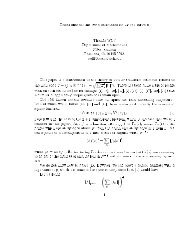Brownian motion and harnack inequality for ... - Math.caltech.edu
Brownian motion and harnack inequality for ... - Math.caltech.edu
Brownian motion and harnack inequality for ... - Math.caltech.edu
Create successful ePaper yourself
Turn your PDF publications into a flip-book with our unique Google optimized e-Paper software.
226 M. AIZENMAN AND B. SIMON<br />
Now introduce a r<strong>and</strong>om variable f with the distribution ae-a,lds. f will be<br />
chosen independently - of q. Notice that the joint probability distribution with<br />
respect to E,. of q(s,), * - - , q(s,,) <strong>and</strong> T 2 s, is<br />
Q.~,(Y*YI). . Q,,-,, , ( Y ~ - I * Y ~ ) ~ * I * * d~n.<br />
with the initial<br />
distribution du(y)-the normalized surface measure on aQ, <strong>and</strong> an independent<br />
variable f. The basic duality result is:<br />
By e we shall denote the expectation of the Markov process { i,.}<br />
THEOREM 3.3. The E-probability distribution of T <strong>and</strong> { b(T - s ) ) ~ ~ , is , ~<br />
identical to the k distribution of f <strong>and</strong> { q(s))o, ,,( i.<br />
Be<strong>for</strong>e proving this theorem, we want to note several things. First, the fact<br />
that we took a ball <strong>for</strong> Q obscures somewhat the general <strong>for</strong>mula <strong>for</strong> the correct<br />
initial distribution <strong>for</strong> q(0). Obviously, we must take the distribution of b( T), i.e.,<br />
(2a)-'(a\l/(y)/an,,)du(y) <strong>for</strong> general "nice" Q.<br />
Secondly, we note that there is a very close relation between I <strong>and</strong> h-<br />
processes of Doob [I I]. In place of Q = JI-'P\l/, Doob considers h-' Ph with h<br />
an excessive function; JI is not an excessive function but it is close enough <strong>for</strong><br />
considerable <strong>for</strong>mal connections. Indeed, various authors (see [ 191, [21]) have<br />
discussed reversal of processes at an exit time in terms of h-processes.<br />
Proof of Theorem 3.3: Since T <strong>and</strong> f have identical distributions, it suffices<br />
to fix 05 sI 5 * - * 5 s, <strong>and</strong> prove the equality of the distributions of<br />
{q(sI), - , q(s,)), conditioned on T L s,,, <strong>and</strong> of { b(T - sI), * * * , b(T - s,,)},<br />
conditioned on T 1 s,,. Let F be a continuous function on 52" <strong>and</strong> fix s 2 s, <strong>and</strong><br />
y > 0. We claim that<br />
where<br />
since the left side of (3.13) is, by the Markov property <strong>for</strong> <strong>Brownian</strong> <strong>motion</strong> (P,<br />
being the kernel of exp( -sHi'j),




